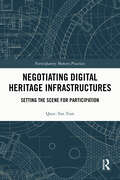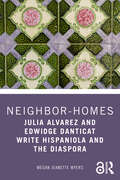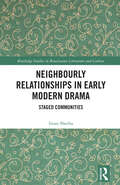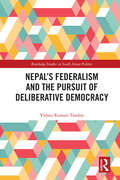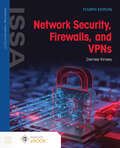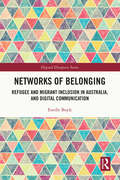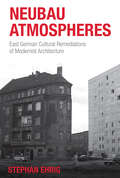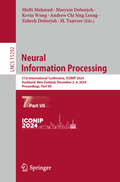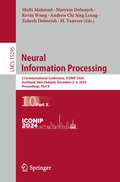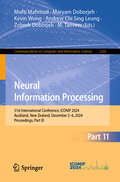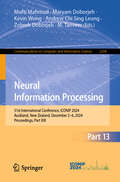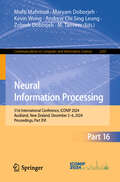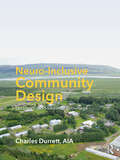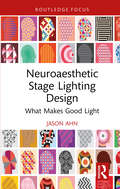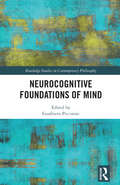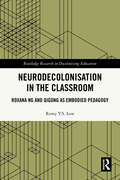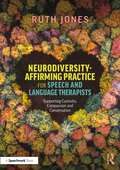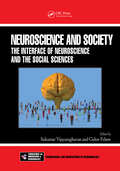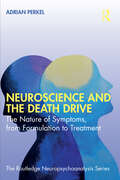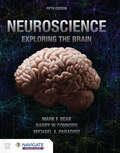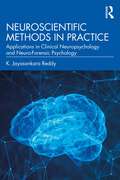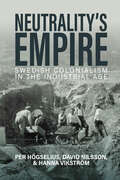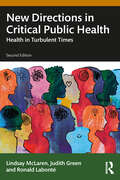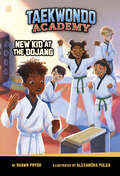- Table View
- List View
Negotiating Digital Heritage Infrastructures: Setting the Scene for Participation (Participatory Memory Practices)
by Quoc-Tan TranNegotiating Digital Heritage Infrastructures examines the infrastructural qualities of museum work that influence the ability of cultural institutions to support participatory and socially inclusive missions.Drawing on data gathered in Scotland, Sweden, and Germany and taking an infrastructure studies approach, the book focuses on the socio-technical negotiations underpinning the everyday practices of museum staff. The book examines the work that is done behind the scenes, including the everyday tasks of collecting, archiving, displaying museum objects and retrieving information. Tran argues that while the technical components of infrastructure are necessary for memory-making and knowledge production, it is the social part of museum infrastructure that enables more open and decentralised modes of memory-making. The book shows how these negotiations affect the ability of museum infrastructures to accommodate and support growth and development, expanding access and establishing modes of connection to external partners and services. It illuminates the less visible practices of museums, which nevertheless directly affect their more public, outward-facing activities.Negotiating Digital Heritage Infrastructures will be of interest to academics and students who are engaged in the study of museums and heritage. It will be particularly useful to those with an interest in public participation, social inclusion, heritage management, the digitisation of collections, data aggregation, and human-centred design approaches.
Neighbor-Homes: Julia Alvarez and Edwidge Danticat Write Hispaniola and the Diaspora
by Megan Jeanette MyersNeighbor-Homes: Julia Alvarez and Edwidge Danticat Write Hispaniola and the Diaspora analyzes the work of two of the most acclaimed contemporary American and Caribbean authors for the first time in a single book. Extending beyond scholarly approaches to home as a theoretical construct, Neighbor-Homes considers how Alvarez and Danticat inaugurate multiple spaces of belonging for their off- and on-island fictional characters, for their diverse community of readers, and for themselves.Revealing a more complex and complete understanding of these Hispaniola-rooted authors, the project places Alvarez and Danticat into conversation at a time when the construction of a border wall and racist immigration laws confirm increasing anti-Haitian sentiment in the Dominican Republic. Neighbor-Homes incorporates correspondence between the two writers to extrapolate diverse narrative representations of Hispaniola and to highlight various themes central to their work and social justice platforms including family relationships, community building, neighbor aesthetics, statelessness, and border solidarity.Neighbor-Homes will help interdisciplinary audiences read Danticat and Alvarez with a more critical eye so that they can more adeptly and profoundly understand Haiti, the Dominican Republic, and their respective diasporas. This important study is an essential read for students and scholars of literature and social justice, cultural studies, history, and politics, as well as Caribbean, Latinx, and African diaspora literatures.
Neighbourly Relationships in Early Modern Drama: Staged Communities (Routledge Studies in Renaissance Literature and Culture)
by Iman SheehaThe book offers the first sustained examination of neighbourly relationships in early modern English drama, situating the close analyses of the selected plays within contemporary prescriptive literature (such as sermons and conduct books), letters, diaries, pamphlets, ballads, wills, proverbs, as well as the lived realities of early modern neighbourhoods as glimpsed in the historical and legal archives. The originality of the book lies in its topic, in the plays chosen for analysis, including Gammer Gurton’s Needle, written in the 1550s and believed to be the first printed vernacular English comedy, and in the revisionist close readings on offer. The plays span the period between 1550s and 1620s, belong to different genres, and were aimed at different audiences and written for different kinds of playhouses, allowing for conclusions to be drawn about the way genre shapes the treatment of neighbourly relationships, as well as revealing continuities and changes in this treatment over the period under study.
Nepal’s Federalism and the Pursuit of Deliberative Democracy (Routledge Studies in South Asian Politics)
by Vishnu Kumari TandonThis book identifies the factors that either encourage or discourage participation and deliberation, thereby demonstrating the potential and reality of deliberative democracy in Nepal at the local level.Focusing on the local level planning process in two municipalities, Buddhabhumi and Dhanushadham, the book examines whether decentralized elements introduced by federalism encourage participation and deliberation or whether they continue to remain a challenge. Throughout this exploration, the author explores how the debate between “common good” and “self-interest” unfolds within the context of deliberative democracy in Nepal. A blend of empirical and theoretical investigation, this book addresses the concept of common good and self-interest in deliberative democracy in the context of unequal societies in South Asia.A pioneering contribution on Nepal, this book will be of interest to researchers studying political science, federalism, participatory democracy, deliberative democracy, and local governance in Nepal and South Asia.
Network Security, Firewalls, and VPNs
by Denise KinseyNetwork Security, Firewalls, and VPNs, Fourth Edition, offers a comprehensive, vendor-neutral introduction to network security, covering firewalls, intrusion detection and prevention systems, and VPNs. Written in a clear and engaging style, the text transitions smoothly from basic principles to advanced topics, incorporating real-world examples and practical applications. Readers will find definitions, operational explanations, and examples that foster a solid understanding of how these technologies function and integrate within networks. The Fourth Edition has been completely rewritten to reflect current technologies and practices, with expanded coverage of SIEM, SOAR, SOC implementation, cloud security, and cryptography uses and protections. It includes hands-on labs and exercises to help readers practice concepts directly. Aligned with the NIST NICE Framework and NSA CAE knowledge units, this edition is well-suited for IT, networking, information systems, and cybersecurity programs. Features and Benefits Rewritten to seamlessly integrate baseline network technologies with new tools for a complete, up-to-date security resource Offers expanded coverage of SIEM, SOAR, SOC implementation, cloud security, and cryptography uses and protections Includes step-by-step, hands-on exercises that help readers apply concepts and build a strong, practical understanding Aligns to NIST NICE Framework v2.0.0 work roles and fully covers NSA CAE Knowledge Units (KUs) for curriculum alignment Provides vendor-neutral, real-world examples to help demonstrate application across devices, systems, and network setups Instructor resources include: Test Bank, PowerPoint Slides, Sample Syllabi, Instructor Manual, Answers to Labs, and more Available with updated cybersecurity Cloud Labs, which provide realistic, hands-on practice that aligns with course content
Networks of Belonging: Refugee and Migrant Inclusion in Australia, and Digital Communication (Digital Diaspora Series)
by Estelle BoyleNetworks of Belonging examines how digitally networked communication technologies create spaces of belonging for people of refugee and migrant backgrounds in resettlement contexts, focusing on Australia.The internet has become a primary facilitator for social connection, transforming how displaced and mobile people maintain relationships across distance. For communities facing significant barriers to connection, such as globally dispersed social networks and often the inability to return to their place of origin, digital technologies can offer vital pathways to belonging and social inclusion in new environments. The book begins by considering the history of refugee and migrant inclusion in Australia and the historical practice of migrant letter-writing, as a critical analogue reference point to today’s digital ubiquity. By investigating how communication technologies enable access to social connection, particularly among those navigating resettlement, the research offers lived perspectives on the evolving nature of digital sociality and its importance for refugee and migrant communities. Three key dyadic relationships of interstitiality frame the analysis: Inclusion-exclusion, digital-physical, and local-global. This approach highlights the nuances of situated lives and personal narratives gathered through qualitative interviews and photo-elicitation with people of refugee and migrant backgrounds in Melbourne, Australia, while advocating for a relational understanding of social inclusion, exclusion, and belonging; digital and physical sociality; and a local and global sense of place. This book will be of value to students and researchers across multiple fields, including media and communications, refugee and migration studies, social inclusion, multiculturalism and belonging, and digital communication.
Neubau Atmospheres: East German Cultural Remediations of Modernist Architecture
by Stephan EhrigThe artistic potential modern, urban housing (“Neubau”) offered to writers and directors in East Germany from the 1960s to 1980s remains underexplored. Neubau Atmospheres seeks to bridge that gap by providing an incisive analysis of East German cinematic, literary, and architectural case studies, highlighting how the modernist housing of the GDR provided a potent vehicle for mediating the emotional and social experience of its denizens. Considering how these cinematic and literary representations focalized ideas of class, gender, and age, author Stephan Ehrig makes a compelling case for viewing this engagement with the urban environment as a cultural genre in its own right.
Neural Information Processing: 31st International Conference, ICONIP 2024, Auckland, New Zealand, December 2–6, 2024, Proceedings, Part II (Communications in Computer and Information Science #2283)
by Kevin Wong M. Tanveer Mufti Mahmud Maryam Doborjeh Andrew Chi Sing Leung Zohreh DoborjehThe sixteen-volume set, CCIS 2282-2297, constitutes the refereed proceedings of the 31st International Conference on Neural Information Processing, ICONIP 2024, held in Auckland, New Zealand, in December 2024. The 472 regular papers presented in this proceedings set were carefully reviewed and selected from 1301 submissions. These papers primarily focus on the following areas: Theory and algorithms; Cognitive neurosciences; Human-centered computing; and Applications.
Neural Information Processing: 31st International Conference, ICONIP 2024, Auckland, New Zealand, December 2–6, 2024, Proceedings, Part VII (Lecture Notes in Computer Science #15292)
by Kevin Wong M. Tanveer Mufti Mahmud Maryam Doborjeh Andrew Chi Sing Leung Zohreh DoborjehThe eleven-volume set LNCS 15286-15296 constitutes the refereed proceedings of the 31st International Conference on Neural Information Processing, ICONIP 2024, held in Auckland, New Zealand, in December 2024.The 318 regular papers presented in the proceedings set were carefully reviewed and selected from 1301 submissions. They focus on four main areas, namely: theory and algorithms; cognitive neurosciences; human-centered computing; and applications.
Neural Information Processing: 31st International Conference, ICONIP 2024, Auckland, New Zealand, December 2–6, 2024, Proceedings, Part X (Lecture Notes in Computer Science #15295)
by Kevin Wong M. Tanveer Mufti Mahmud Maryam Doborjeh Andrew Chi Sing Leung Zohreh DoborjehThe eleven-volume set LNCS 15286-15295 constitutes the refereed proceedings of the 31st International Conference on Neural Information Processing, ICONIP 2024, held in Auckland, New Zealand, in December 2024. The 318 regular papers presented in the proceedings set were carefully reviewed and selected from 1301 submissions. They focus on four main areas, namely: theory and algorithms; cognitive neurosciences; human-centered computing; and applications.
Neural Information Processing: 31st International Conference, ICONIP 2024, Auckland, New Zealand, December 2–6, 2024, Proceedings, Part XI (Communications in Computer and Information Science #2292)
by Kevin Wong M. Tanveer Mufti Mahmud Maryam Doborjeh Andrew Chi Sing Leung Zohreh DoborjehThe sixteen-volume set, CCIS 2282-2297, constitutes the refereed proceedings of the 31st International Conference on Neural Information Processing, ICONIP 2024, held in Auckland, New Zealand, in December 2024.The 472 regular papers presented in this proceedings set were carefully reviewed and selected from 1301 submissions. These papers primarily focus on the following areas: Theory and algorithms; Cognitive neurosciences; Human-centered computing; and Applications.
Neural Information Processing: 31st International Conference, ICONIP 2024, Auckland, New Zealand, December 2–6, 2024, Proceedings, Part XIII (Communications in Computer and Information Science #2294)
by Kevin Wong M. Tanveer Mufti Mahmud Maryam Doborjeh Andrew Chi Sing Leung Zohreh DoborjehThe sixteen-volume set, CCIS 2282-2297, constitutes the refereed proceedings of the 31st International Conference on Neural Information Processing, ICONIP 2024, held in Auckland, New Zealand, in December 2024.The 472 regular papers presented in this proceedings set were carefully reviewed and selected from 1301 submissions. These papers primarily focus on the following areas: Theory and algorithms; Cognitive neurosciences; Human-centered computing; and Applications.
Neural Information Processing: 31st International Conference, ICONIP 2024, Auckland, New Zealand, December 2–6, 2024, Proceedings, Part XVI (Communications in Computer and Information Science #2297)
by Kevin Wong M. Tanveer Mufti Mahmud Maryam Doborjeh Andrew Chi Sing Leung Zohreh DoborjehThe sixteen-volume set, CCIS 2282-2297, constitutes the refereed proceedings of the 31st International Conference on Neural Information Processing, ICONIP 2024, held in Auckland, New Zealand, in December 2024. The 472 regular papers presented in this proceedings set were carefully reviewed and selected from 1301 submissions. These papers primarily focus on the following areas: Theory and algorithms; Cognitive neurosciences; Human-centered computing; and Applications.
Neuro-Inclusive Community Design: Lessons from Sólheimar Ecovillage
by Charles DurrettThis book is an inspiring exploration of Sólheimar Ecovillage in Iceland, a pioneering community that embodies sustainability, social responsibility, and inclusivity.Cohousing expert Charles Durrett delves into the unique aspects of this ecovillage of about 100 residents, 45 of whom include those with developmental and intellectual disabilities, who live and thrive alongside neighbors in a safe and enriching environment. Through rich storytelling and detailed first-person accounts, the book highlights the importance of creating communities that celebrate and support neurodiversity. Durrett presents Sólheimar as a model for how we can build neuro-inclusive spaces that respect and uplift every individual’s potential, fostering a sense of belonging and purpose. The book offers practical insights into the design, the principles, and the practices that make Sólheimar a standout community for inclusive living. It challenges readers to rethink conventional approaches, advocating for environments where all people, regardless of their cognitive differences, can live meaningful and fulfilling lives. Durrett also presents case studies of four other neuro-inclusive communities, including Hertha Levefallesskab, WeBUILT (We Build Unique Independent Lives Together), Creative Living Community of CT, and L’Arche International Movement. With its focus on real-world solutions and its call to action, this book is both a guide and an inspiration for anyone interested in the intersection of sustainability, community living, and neuro-inclusivity.It will have a broad audience of architects, designers, occupational therapists, mental health professionals, housing developers, and practitioners in housing and social care, among others.
Neuroaesthetic Stage Lighting Design: What Makes Good Light
by Jason AhnNeuroaesthetic Stage Lighting Design redefines stage lighting through the lens of neuroaesthetics, exploring how light shapes human perception, emotion, and experience. Interweaving science, philosophy, and art, it reveals the power of lighting to enhance beauty and meaning on the stage.This book provides a comprehensive exploration of the aesthetic and functional principles of light by weaving together multiple threads of interdisciplinary integration, faithful reproduction of natural light, scientific foundation, and visual symbolism. It explores lighting that mimics originals, including natural light to enhance beauty and audience immersion, explains the biological and psychological effects of light on human experience, and examines how set, lighting, costumes, and videos contribute to the performance's imagery and audience perception. By using scientifically informed lighting design, the book seeks to create immersive and fully emotional performances. It encourages lighting designers to adopt an interdisciplinary, artistically informed approach and provides valuable insights into the lighting design process, surpassing traditional technical manuals.A compelling read for theatre professionals, designers, students and researchers of neuroaesthetics, and anyone curious about the meaning and reasons behind beauty, Neuroaesthetic Stage Lighting Design reimagines lighting as an essential component of human experience and artistic excellence.
Neurocognitive Foundations of Mind (Routledge Studies in Contemporary Philosophy)
by Gualtiero PiccininiThis volume provides a cohesive and comprehensive case that cognitive neuroscience is maturing into an integrated, interdisciplinary science that is transforming our understanding of the mind.The rise of cognitive neuroscience has prompted a rethinking of levels, computation, representation, psychological explanation, and the relation between psychology and neuroscience. Despite these advances, many philosophers and scientists of the mind continue to write as though cognitive neuroscience didn’t exist and psychology remains autonomous from neuroscience or, perhaps, they maintain that cognitive neuroscience has not deepened our understanding of the mind. The chapters in this volume showcase important ways in which cognitive neuroscience makes a profound difference to our understanding of the mind. The contributors address a wide range of topics, including explanation, computation, representation, inference, emotion, language, intention, and thought. Together, they demonstrate the ways in which cognitive neuroscience supersedes traditional cognitive science and supports a unified, integrated, multilevel, mechanistic, neurocomputational account of the mind.Neurocognitive Foundations of Mind is essential reading for scholars and advanced students interested in the foundations of the philosophy of mind and the mind sciences.
Neurodecolonisation in the Classroom: Roxana Ng and Qigong as Embodied Pedagogy (Routledge Research in Decolonizing Education)
by Remy Y.S. LowThis book extends on the scholarship on decolonising higher education by focusing on classroom pedagogies that can transform students’ embodied affects and habits as conditioned by coloniality.It does so by offering a historical case study of how one exemplary educator – Canadian activist and scholar Roxana Chu-Yee Ng (1951–2013) – drew on traditional Chinese medicine philosophy and Qigong practice to offer an embodied pedagogy that had profound effects on many of her students.This book brings together scholarship from critical education, contemplative pedagogy, the neuroscience of stress, mind–body medicine, and embodied cognition to make the case for the importance of embodied pedagogies in any project for decolonising higher education. An innovative contribution to embodiment and decolonial studies, this book will be of great interest to researchers and postgraduate students exploring interdisciplinary methods.
Neurodiversity-Affirming Practice for Speech and Language Therapists: Supporting Curiosity, Compassion and Conversation
by Ruth JonesAre you a speech and language therapist (SLT) working independently, within a speech and language therapy team, or in training? Do you, or might you work with autistic or other neurodivergent people? This book will help you understand the changing narrative around how we support neurodivergent individuals, how to sit with complex thoughts and feelings you may have, and how to grow your capacity to unlearn, adapt and shift your values and practice.This essential guide considers what neurodiversity is and what it means to practice in a neurodiversity-affirming way, considering why we should be doing so and, importantly, how to do it. The book moves through the context of neurodiversity in recent times and considers key historical approaches within speech and language therapy. Chapters offer space for reflective practice based on what we know now, for both individual reflection and with colleagues as part of a wider team, before introducing practical strategies to challenge and change how we work with neurodivergent individuals. Throughout, the voices of autistic and ADHD SLTs are included and amplified, sharing their lived experiences and perspectives to further support teams to develop neurodiversity-informed practice.This book offers a safe and supportive space to explore a topic that can be uncomfortable and scary but must be delved into to provide neurodivergent people with access to therapists with knowledge, skills, and advocacy approaches to best meet their needs. It will be crucial reading for all practising and training speech and language therapists.
Neuroscience and Society: The Interface of Neuroscience and the Social Sciences (Frontiers in Neuroscience)
by Sukumar Vijayaraghavan Gidon FelsenAdvances in neuroscience research are rapidly redefining what it means to be human. The absence of the brain/mind dichotomy has, in turn, removed the separation between our brain biology and our sociocultural experiences, raising questions for social sciences to address. How responsible are we, as individuals, for our actions? Do we have free will? Is it ethical for us to peer into others’ brains? How are our collective social cultural norms influenced by our brain function? At the same time, neuroscientists need to develop better intuition about the ethical, legal, and social implications of their research. Close collaboration between neuroscience and social sciences is the best way forward.This book acts as an introduction to these and other issues that lie at the interface of neuroscience and social sciences, using the physiological underpinnings of our decision-making processes as a framework. Examples of topics addressed here are: Neuroscience and economics Neuroscience and law Neuroscience and ethics Neuroscience and mental health Neuroscience of religion and humour The book is intended for students of neuroscience and social sciences, as well as readers generally interested in the human condition. It is hoped that the book will stimulate cross-disciplinary thinking and inspire a new generation of thinkers who are willing to look at both social sciences and neuroscience research with a different lens. Such bridge builders will be the pioneers of the next level of interrogation at this emerging interface.
Neuroscience and the Death Drive: The Nature of Symptoms, from Formulation to Treatment (The Routledge Neuropsychoanalysis Series)
by Adrian PerkelIn this book, Adrian Perkel seeks to expand upon Freud’s theory of the death drive by locating it within modern neuroscience, arguing for the centrality of the aggressive drive in the formation of mind, and the genesis of symptoms and psychopathology. Neuroscience and the Death Drive reformulates the function of defence mechanisms as they link to the aggressive drive and their role in the binding of free energy. Filling an important gap in both formulation and treatment, this book completes Freud’s self-confessed incomplete theory of aggression through the lens of modern psychoanalysis and neuroscience, updating these concepts with current scientific insights, and introduces a refreshed view on psychotherapeutic treatment implications based on these developments. Perkel explores the treatment of patients experiencing eating disorders, anxiety, depression, addiction, personality disorders and sexual dysfunction. This invigorating and approachable book will be of interest to all psychoanalysts, psychiatrists, psychotherapists and counsellors, and will help readers reach new understandings of this key theory of the mind.
Neuroscience: Exploring the Brain
by Michael A. Paradiso Mark Bear Barry ConnorsNeuroscience: Exploring the Brain, Fifth Edition delivers a comprehensive, student-friendly introduction to the structure and function of the nervous system. Updated to reflect the latest research, this edition blends foundational science with engaging, real-world applications, making it ideal for introductory neuroscience or biological psychology courses across a wide range of departments, from psychology to allied health. With an approachable tone, expanded illustrations, and thoughtful pedagogy, this trusted text makes complex topics more accessible, even for students without a strong background in science.The Fifth Edition is distinguished by its clarity, adaptability, and practical relevance. It engages students through clear explanations, relatable scientific stories, and real-world connections, making complex material easier to grasp. Instructors also benefit from features that streamline course planning and support a variety of teaching and learning styles. Updated Content and Illustrations: Chapters reflect new neuroscience research, with improved visuals for improved clarity and engagement.Neuroscience and Medicine Boxes: Highlight the significance of material and connect concepts to real-world medical applications.Path of Discovery Boxes: Firsthand accounts from field experts and Nobel laureates that outline key discoveries and their broader impact.Brain Byte and Brain Food Boxes: Curiosity-sparking sidebars that offer fun facts or deeper dives into select topics to keep students engaged.Student-Focused Pedagogy: Each chapter includes learning objectives, review questions, and a glossary to reinforce understanding.Instructor Resources: Lecture slides, test questions, and chapter outlines that save instructors time and support effective course delivery. © 2026 | 975 pages
Neuroscientific Methods in Practice: Applications in Clinical Neuropsychology and Neuro-Forensic Psychology
by K. Jayasankara ReddyThis book presents an in-depth exploration of the convergence of neuroscience with clinical psychology, clinical neuropsychology, and forensic psychology, examining advanced methodologies, practical applications, and real-world case studies.K. Jayasankara Reddy provides a thorough examination of state-of-the-art neuroscientific methods and the revolutionary effects on both diagnosis and forensic inquiry. Reddy highlights the transformative impact of neuroimaging, neurophysiology, neuroelectrophysiology, and genetic analysis on our comprehension of brain function and behavior, using compelling case examples and empirical evidence. This book not only discusses methods but also critically examines ethical difficulties, merits, and challenges of the techniques, as well as the legal ramifications that may arise from the use of neuroscientific evidence in clinical and forensic settings. This book also highlights the need for a sophisticated comprehension of privacy issues, patient self-governance, and the use of neurobiological information within legal structures.Overall, it provides readers with the tools to negotiate complicated ethical landscapes while responsibly utilizing neuroscientific discoveries, advocating for a balanced approach that combines scientific rigor and ethical responsibility. This volume is an important resource for students, researchers, and practitioners of clinical neuropsychology, forensic psychology, and neuroscience.
Neutrality’s Empire: Swedish Colonialism in the Industrial Age
by Per Högselius David Nilsson Hanna VikströmReconciling Sweden’s reputation for political neutrality and scientific prestige alongside its involvement in extractivist colonial projects exposes uncomfortable overlaps between these seemingly disparate ventures. In this illuminating reappraisal of the intersections between Swedish colonialism and its industrial history, Neutrality’s Empire explores how Swedish actors—ranging from diplomats and business leaders to missionaries, geologists and engineers—leveraged Sweden’s global standing to access valuable mineral resources across Africa and Asia. In doing so, this book presents a historical narrative which clarifies Sweden’s entanglement with the forces of globalization, colonialism, and climate change.
New Directions in Critical Public Health: Health in Turbulent Times
by Judith Green Lindsay McLaren Ronald LabonteIn an era where debates about public health research, policy, and practice are central to the wider socio-political discourse, this invaluable volume brings together key themes from the last 15 years of critical scholarship in and of public health.The book provides both empirical examples and the conceptual tools for rethinking the role of public health in society, challenging the familiar biomedicalized and individualized discourse that has dominated throughout the COVID-19 pandemic. Divided into nine chapters, it covers key topics such as complex systems of health determinants, evidence-making in public health, and the role of corporate actors and philanthropists. Reframing the field through local and global political lenses, New Directions in Critical Public Health: Health in Turbulent Times also integrates interdisciplinary perspectives to provide a truly holistic overview of this rapidly evolving area.It will interest not only students and scholars of public health and the health sciences more widely, but also those in the fields of sociology, political and development studies, and economics.
New Kid at the Dojang
by Shawn PryorWhen a new kid named Julian joins the dojang, Ezra's friends are focused on making the new student feels welcome. They miss Ezra's latest accomplishment: breaking three boards. Feeling jealous, Ezra thoughtlessly dares Julian to try a skill that is beyond Julian's ability. Will Julian's first class at the dojang be his last?
